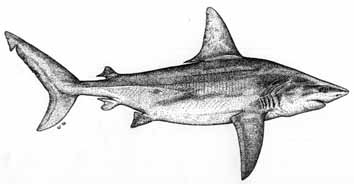Sandbar Shark (Carcharhinus plumbeus)

(Nardo, 1827).
| Fr: |
Requin gris |
| Sp: |
Tiburon trozo; Tauro plom (Catalunya);
Tiburon de Milberto; Tintorera (Tarragona) |
| It: |
Squalo grigio; Vaccotta (Catania);
mangialice (Naples) |
| Ma: |
Kelb griz |
| Scientific names recently used: |
Carcharhinus milberti
(Valenciennes in Müller & Henle,
1839) |
Diagnosis
A stout, drab-coloured requiem shark with a conspicuously tall
first dorsal fin; snout rather short and rounded and an interdorsal
ridge. The 1st dorsal fin, with a slightly rounded or pointed
apex, is considerably more prominent and sail-like in mature adults
than juveniles, its height 13.6 to 16.5% of TL; origin lies above or
anterior to the pectoral axils; pectoral fins quite large;
second dorsal fin moderately large. The anal fin, of similar
size to the 2nd dorsal, has its origin sited directly below or
marginally posterior to the 2nd dorsal origin. Upper-jaw teeth
broad and triangular, margins serrated but without cusplets.
Colour mid-brown to grey-brown dorsally, fading to white ventrally
with an indistinct, horizontal band of darker pigment invading the
white colour on the belly-flanks. No conspicuous fin-markings
although the tips and posterior margins may appear dusky,
particularly in younger Mediterranean examples seen by the writer.
Size
To 248cm; Mediterranean specimens typically 100 to 230cm with
size at birth 58 to 65cm based on Tunisian examples from the Gulf of
Gabes (Capape, 1984).
Status and Distribution
Mediterranean Sea: Rather common in select
southern-central areas, particularly off Tunisia; also Libya, Egypt
and within the Sicilian Channel. Occasional off Spain, the
Balearics, Gulf of Lyons, Riviera and Cote dıAzur, Sardinia, Corsica
and western mainland Italy from Genova southwards; also Malta and
the Isole Pelagie; now appears rare or even absent at the
type-locality (Venice; N. Adriatic Sea) and is increasingly scarce
elsewhere in northern-central Adriatic waters, although specimens
are sporadically caught off Puglia Region, Italy. Ranges
throughout the Eastern basin and Aegean Sea, but commoner in
southern parts.
Biology
A coastal shark, often in shallow waters associated with sandy or
muddy flats, bays, estuaries and harbours (but not actually within
rivers); also further offshore, particularly on banks, near islands,
flat reefs and other topographic features in open waters.
Sandbars occur from the surfline down to 200m (caught at this depth,
on the bottom, in Sicilian Channel trawls) and to 280m in other
regions, but typically in waters less than 100m and frequently
patrolling near the seabed. These sharks predate upon demersal
and benthic bony fish such as flounders, gurnards, groupers, morays
and other eels, also mackerel, sardines, bonito, bullet tuna, jacks,
mullets and other pelagic schooling fish; small sharks such as
Squalus spp., batoids including Dasyatid rays; invertebrates
such as squid, cuttlefish, octopi, bivalves, crabs and
shrimps. Viviparous. Litter size variable, from 3-14
pups and typically 5 -12, correlated to maternal size; a pupping and
nursery-zone for these sharks is sited within Tunisiaıs Gulf of
Gabès where parturition occurs during the summer months after a
gestation period of about one year (Capapé, 1984). Other
earlier gravid females have been reported from Naples (a 150cm
example with 15 embryos; Lo Bianco, 1909) and Nice (foetal specimens
taken in 1885; Tortonese, 1950). Mating in Tunisian waters
probably occurs through May and June. Females mature at
170cm and reach 248cm, males mature at 166cm and attain 225cm.
The Shark Trust, 36 Kingfisher Court, Hambridge Road, Newbury, Berkshire, RG14 5SJ, UK.
Tel(+44) 01635 551150, Fax(+44) 01635
550230
|